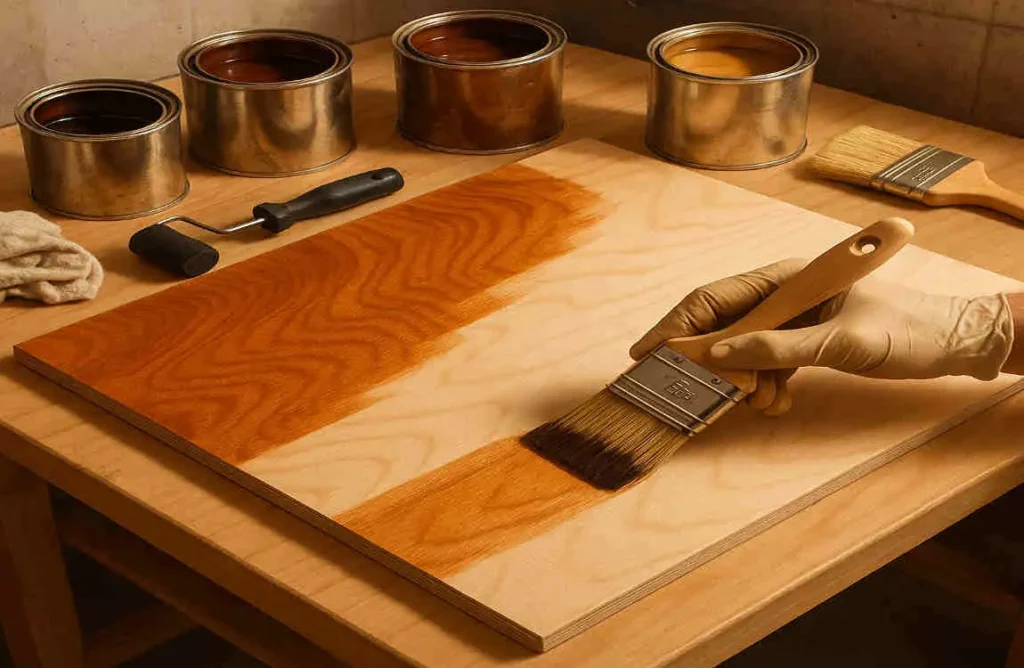Plywood is a versatile material that has become a staple in home building and renovation projects. Its layered structure offers strength and stability, making it a popular choice for everything from flooring to cabinetry. However, to truly maximise the benefits of plywood, staining house plywood is essential. Staining not only enhances the visual appeal of the plywood but also provides protection against wear and tear, ensuring longevity.
Understanding Plywood and Its Characteristics

Types of Plywood Used in Houses
Plywood comes primarily in two types: hardwood and softwood.
- Hardwood Plywood: Made from deciduous trees such as oak, maple, or birch, hardwood plywood is denser and typically more durable. It’s ideal for furniture and cabinetry.
- Softwood Plywood: Produced from coniferous trees like pine and spruce, softwood plywood is lighter and easier to work with. It’s often used for construction and less visible applications.
Staining Capabilities
Unlike solid wood, plywood’s layered structure can affect how it absorbs stains. The surface of plywood is often made from a thin veneer, which can lead to uneven staining if not prepared correctly.
Specific Techniques for Staining Plywood
Staining plywood requires special care due to its surface porosity and the presence of veneer layers. Here’s why:
- Porosity: Different plywood types absorb stains at different rates, which can lead to blotchiness if not correctly managed.
- Veneer Layers: Plywood consists of thin layers glued together, and the grain may not be uniform, making it essential to apply stains carefully.
Benefits of Staining Plywood
Staining plywood not only protects it from the elements but also highlights the natural grain, making it look more attractive. Additionally, it can significantly extend the life of the material, which is crucial for any home project.
Preparing House Plywood for Staining
Choosing the Right Plywood for Staining
You may also read (top 10 kitchen fitter house tools for professionals).
When you decide to stain plywood, the first step is to choose the right type:
- Hardwood Plywood: These types usually absorb stain evenly and provide a rich finish. They are often the preferred choice for visible projects.
- Softwood Plywood: While more affordable, softwood plywood can be prone to blotching. Using a wood conditioner can help mitigate this issue.
Surface Preparation
Preparation is crucial for achieving a smooth finish:
- Sanding: Start with a medium-grit sandpaper (around 120 grit) and work your way up to a finer grit (220 grit) for a smooth surface. This helps the stain adhere better.
- Cleaning: After sanding, make sure to remove all dust and debris. A clean, dry cloth can help eliminate any residue that could interfere with the staining process.
- Using Wood Conditioner: For softwood plywood, applying a wood conditioner can prevent blotchy areas and ensure a more uniform stain application.
Workspace and Tools Preparation
Creating a suitable workspace is essential for the staining process:
- Ventilation: Ensure your area is well-ventilated to avoid inhaling fumes from the stain.
- Dust-Free: A clean environment will prevent dust from settling on your freshly stained surface.
Necessary Tools
You may also read (what are the largest house roofing manufacturers in europe).
Here’s a quick list of tools you’ll need for the job:
- Sandpaper (medium and fine grit)
- Brushes or rags (for applying the stain)
- Wood conditioner (optional for softwood)
- Stain (choose based on your preference)
- Protective gloves
- Cleaning cloths
Choosing the Best Stain for House Plywood

Overview of Stain Types
When it comes to stains, you’ll generally find two main categories: oil-based and water-based.
Oil-Based Stains
- Pros: Deep penetration, richer colour, and long-lasting durability.
- Cons: Longer drying time and more pungent odour during application.
Water-Based Stains
- Pros: Quick drying, easier cleanup with soap and water, and lower odour.
- Cons: May require multiple coats for a deep colour.
Gel Stains
Gel stains are thicker and can be ideal for plywood, especially if you’re looking for a more controlled application. They can help prevent runs and drips, making them an excellent option for vertical surfaces.
Selecting the Right Stain
When choosing a stain, consider the size of your project and the desired finish. For larger projects, you might prefer a water-based stain due to its quick drying time, while smaller applications might benefit from the richer finish of an oil-based stain.
Step-by-Step Guide to Staining House Plywood
Stir and Test the Stain
Before applying any stain, it’s crucial to stir it well to achieve a uniform consistency. Always conduct a test on a scrap piece of plywood to see how the stain looks once applied.
Applying the Stain
When it comes to application, follow these techniques:
- Brush Application: Use a high-quality brush to apply the stain. Work with the grain of the wood to ensure an even finish.
- Rag Application: For a more hands-on approach, use a clean rag to apply the stain. This can allow for better control and less mess.
- Foam Brush: A foam brush can also work well, especially for intricate areas.
Wiping Off Excess Stain
After applying the stain, it’s essential to wipe off any excess after about 5-15 minutes, depending on the product instructions. Use a clean rag and follow the grain to avoid streaks.
Drying Time and Additional Coats
Drying times can vary based on the type of stain:
- Oil-Based Stains: Usually take longer to dry (up to 24 hours).
- Water-Based Stains: Can dry in as little as 1-2 hours.
If you desire a deeper colour, consider applying additional coats. However, avoid sanding between coats unless specified, and ensure the final jacket is sanded lightly for a smooth finish.
Finishing the Stain
To protect your stained plywood, applying a clear finish is recommended. Two popular options are:
- Polycrylic: Ideal for indoor projects, polycrylic offers a clear finish with a lower odour.
- Polyurethane: More durable for surfaces that will see heavy use, polyurethane provides excellent protection.
Final Application
Apply the finish with a clean brush or spray, ensuring even coverage. Follow the manufacturer’s instructions for drying times and additional coats.
Common Mistakes to Avoid When Staining House Plywood
- Skipping Sanding: This can lead to a rough finish and poor stain adhesion.
- Not Testing Stain: Always test your stain to avoid unpleasant surprises.
- Ignoring Grain Direction: Applying stain against the grain can lead to streaks and uneven colour.
- Leaving Excess Stain: This can cause blotches; always wipe off excess.
- Rushing Drying Times: Allow adequate drying time between coats to ensure the best results.
Tips for a Professional-Looking Finish
Quality Tools Make a Difference
Using quality brushes and rags can significantly affect the outcome of your project. Invest in good tools for a better finish.
Proper Lighting
Make sure to work in good lighting to check the evenness of your stain application. This helps in spotting areas that may need more attention.
Blending Techniques
If you notice any uneven spots, use a rag or brush to blend them in while the stain is still wet for a smoother look.
Storing Leftover Stain
If you have leftover stain, store it properly for future touch-ups. Ensure the container is sealed tightly and kept in a cool, dry place.
You may also read (how to effectively clean house door handles).

